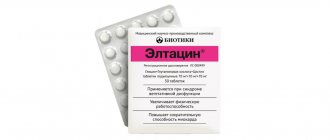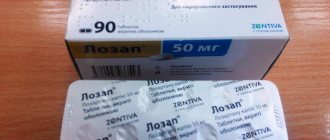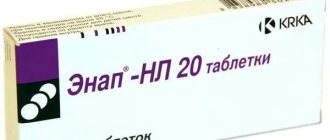pharmachologic effect
Bronchodilator, methylxanthine derivative; inhibits phosphodiesterase, increases the accumulation of cyclic adenosine monophosphate (cAMP) in tissues, blocks adenosine (purine) receptors; reduces the flow of calcium ions through the channels of cell membranes, reduces the contractile activity of smooth muscles.
Relaxes the bronchial muscles, stimulates the respiratory center and improves alveolar ventilation, which ultimately leads to a reduction in the severity and frequency of apnea episodes.
It has a stimulating effect on the activity of the heart, increases the strength and frequency of heart contractions, increases coronary blood flow and myocardial oxygen demand. Reduces the tone of blood vessels (mainly those of the brain, skin and kidneys). It has a peripheral venodilating effect, reduces pulmonary vascular resistance, and lowers pressure in the pulmonary circulation. Increases renal blood flow and has a moderate diuretic effect. Expands extrahepatic bile ducts.
Stabilizes mast cell membranes, inhibits the release of mediators of allergic reactions.
Inhibits platelet aggregation (suppresses platelet activating factor and prostaglandin E2 alpha), increases the resistance of red blood cells to deformation (improves the rheological properties of blood), reduces thrombus formation and normalizes microcirculation.
It has a tocolytic effect, increases the acidity of gastric juice. When used in large doses, it has an epileptogenic effect.
Pharmacokinetics
Bioavailability and absorption kinetics depend on the dosage form of the drug. Bioavailability for liquid dosage forms is 90-100%. The time to reach the maximum concentration of the drug in plasma with intravenous administration of 0.3 g is 15 minutes, the maximum concentration of the drug in the blood is 7 mcg/ml. The volume of distribution is in the range of 0.3-0.7 l/kg (30-70% of “ideal” body weight), with an average of 0.45 l/kg. Communication with plasma proteins in adults - 60%, in newborns - 36%, in patients with liver cirrhosis - 36%. Penetrates into breast milk (10% of the dose taken), through the placental barrier (the concentration in the fetal blood serum is slightly higher than in the maternal serum).
Aminophylline exhibits bronchodilating properties in concentrations of 10-20 mcg/ml. Concentrations above 20 mg/ml are toxic. The stimulating effect on the respiratory center is realized at a lower content of the drug in the blood - 5-10 mcg/ml.
Metabolized at physiological pH values with the release of free theophylline, which is further metabolized in the liver with the participation of several cytochrome P450 isoenzymes. As a result, 1,3-dimethyluric acid (45-55%) is formed, which has pharmacological activity, but is 1-5 times inferior to theophylline. Caffeine is an active metabolite and is formed in small quantities, with the exception of premature newborns and children under 6 months, in whom, due to the extremely long half-life of caffeine, its significant accumulation in the body occurs (up to 30% of that for aminophylline).
In children over 3 years of age and in adults, the phenomenon of caffeine accumulation is absent.
The half-life in newborns and children under 6 months is more than 24 hours; in children older than 6 months. — 3.7 hours; in adults - 8.7 hours; for “smokers” (20-40 cigarettes per day) - 4-5 hours (after quitting smoking, pharmacokinetics normalize after 3-4 months); in adults with chronic obstructive pulmonary disease, pulmonary heart disease and pulmonary heart failure - over 24 hours. Excreted by the kidneys. In newborns, about 50% of theophylline is excreted unchanged in the urine versus 10% in adults, which is associated with insufficient activity of liver enzymes.
Pharmacological effects
The main effect of the drug is antispasmodic. However, it also has other effects on the human body, namely tocolytic, diuretic and bronchodilator.
According to the Vidal classifier, Eufillin is included in the pharmacological group of phosphodiesterase inhibitors.
What does Eufillin help with? Indications for use
Indications for use of the drug Eufillin may vary slightly depending on the form of release. Tablets are most often prescribed for:
- Bronchial asthma of varying severity.
- Chronic obstructive pulmonary disease.
- Paroxysmal attacks of apnea at night.
- Right ventricular heart failure.
- Emphysema.
The injection form of the drug is used for:
- Cerebrovascular insufficiency of the brain (the drug is used in combination with other drugs and helps reduce intracranial pressure).
- Pulmonary hypertension.
- Left ventricular heart failure (also used in combination with a number of other drugs).
- For diseases of the respiratory system accompanied by spasm and broncho-obstructive syndrome (COPD, emphysema, bronchial asthma).
Contraindications
Hypersensitivity to the drug (including other xanthine derivatives: caffeine, pentoxifylline, theobromine), severe arterial hypotension or hypertension, paroxysmal tachycardia, extrasystole, myocardial infarction with cardiac arrhythmias, epilepsy, increased convulsive readiness, hypertrophic obstructive cardiomyopathy , thyrotoxicosis, pulmonary edema, severe coronary insufficiency, liver and/or renal failure, hemorrhagic stroke, retinal hemorrhage, recent history of bleeding.
Carefully
Severe coronary insufficiency (acute phase of myocardial infarction, angina pectoris), widespread vascular atherosclerosis, hypertrophic obstructive cardiomyopathy, frequent ventricular extrasystole, increased convulsive readiness, liver and/or renal failure, peptic ulcer of the stomach and duodenum (history), bleeding from gastrointestinal tract in a recent history, uncontrolled hypothyroidism (possibility of cumulation) or thyrotoxicosis, prolonged hyperthermia, gastroesophageal reflux, prostatic hypertrophy, children under 14 years of age, old age (over 55 years).
Prescribe with caution simultaneously with anticoagulants, with other theophylline and purine derivatives.
Use during pregnancy and breastfeeding
If necessary, prescribing the drug during pregnancy should be compared
expected benefit to the mother and potential risk to the fetus.
If it is necessary to use the drug during lactation, breastfeeding should be discontinued.
Newborns whose mothers received aminophylline during pregnancy (especially the third trimester) require medical supervision to monitor possible symptoms of methylxanthine intoxication.
Indications
For parenteral use: status asthmaticus (additional therapy), neonatal apnea, ischemic cerebrovascular accident (as part of combination therapy), left ventricular failure with bronchospasm and Cheyne-Stokes type breathing disorder, edematous syndrome of renal origin (as part of complex therapy) ; acute and chronic heart failure (as part of combination therapy).
For oral administration: broncho-obstructive syndrome of various origins (including bronchial asthma, COPD, including emphysema, chronic obstructive bronchitis), hypertension in the pulmonary circulation, cor pulmonale, sleep apnea; acute and chronic heart failure (as part of combination therapy).
special instructions
Use caution when consuming large amounts of caffeine-containing foods or drinks during treatment.
Elderly patients are recommended to reduce the dose of the drug due to its slow elimination from the body.
Smoking patients are advised to increase the dose due to the accelerated elimination of the drug from the body.
Before use, the drug solution must be warmed to body temperature.
Impact on the ability to drive vehicles and machinery.
During the treatment period, care must be taken when driving vehicles and engaging in other potentially hazardous activities that require increased concentration and speed of psychomotor reactions.
Use during pregnancy and breastfeeding
Theophylline penetrates the placental barrier. The use of aminophylline during pregnancy may result in potentially dangerous concentrations of theophylline and caffeine in the blood plasma of the newborn. Newborns whose mothers received aminophylline during pregnancy (especially in the third trimester) require medical supervision to monitor possible symptoms of theophylline intoxication.
Theophylline is excreted in breast milk. When using aminophylline in a nursing mother during lactation, irritability may occur in the child.
Thus, the use of aminophylline during pregnancy and lactation (breastfeeding) is possible in cases where the expected benefit of therapy for the mother outweighs the potential risk for the fetus or child.
Directions for use and doses
Adults are injected into a vein slowly (over 4-6 minutes) with 5-10 ml of a solution with a concentration of 24 mg/ml (0.12-0.24 g), which is pre-diluted in 10-20 ml of isotonic sodium chloride solution. If palpitations, dizziness, or nausea occur, the rate of administration is slowed down or switched to drip administration, for which 10-20 ml of a solution with a concentration of 24 mg/ml (0.24-0.48 g) is diluted in 100-150 ml of isotonic sodium chloride solution; administered at a rate of 30-50 drops per minute. Eufillin is administered parenterally up to 3 times a day, for no more than 14 days.
Higher doses of aminophylline for adults into a vein: single - 0.25 g, daily - 0.5 g.
Children under 14 years of age are advised to use the drug with caution due to possible side effects.
However, if necessary, children are administered aminophylline intravenously at a single dose of 2-3 mg/kg, preferably by drip.
Higher doses for children intravenously: single - 3 mg/kg, daily - up to 3 months of age. -0.03-0.06 g,
from 4 to 12 months. - 0.06-0.09 g,
from 2 to 3 years - 0.09-0.12 g,
from 4 to 7 years - 0.12-0.24 g,
from 8 to 18 years - 0.25-0.5 g.
Eufillin 2.4% 5 ml No. 10 amp.
Euffilin 2.4% 5ml No. 10 ampoules
Trade name Eufillin International nonproprietary name Aminophylline Dosage form Solution for intravenous administration 2.4% 5 ml Composition 5 ml of solution contains the active substance - aminophylline for injection in terms of anhydrous substance 120 mg, excipient - water for injection. Description Transparent colorless or slightly yellowish liquid
Pharmacotherapeutic group Other drugs for the treatment of obstructive airway diseases for systemic use. Xanthines. ATC code R03DA05 Pharmacological properties Pharmacokinetics After intravenous administration, it is 60% bound to blood proteins (with liver cirrhosis, the proportion of the protein-bound fraction decreases to 35%, and in newborns this figure is 36%). Penetrates well through histohematic barriers and is evenly distributed in the blood, extracellular fluid and muscle tissue. Does not accumulate in adipose tissue. Penetrates through the placental barrier and into mother's milk. The volume of distribution is 0.3-0.7 l/kg (average 0.45 l/kg). The bronchodilator effect is manifested when its concentration in the blood plasma is maintained at a level of 10-20 mcg/ml. Concentrations of aminophylline in plasma above 20 mcg/ml are toxic. Subjected to intensive metabolism in the liver (about 90%), under the influence of methylases and cytochrome P450, it is partially converted into caffeine. In children under 3 years of age, the concentration of caffeine can reach 30% of the concentration of aminophylline. In adults and children over 3 years of age, the phenomenon of caffeine accumulation is not observed. It is excreted by the kidneys, 10% in adults and about 50% in children - unchanged. The half-life of aminophylline (T1/2) in newborns and children under 6 months is >24 hours; in children over 6 months - 3.7 hours; in adults who do not suffer from bronchopulmonary pathology - 8.7 hours. In persons who smoke 20-40 cigarettes per day, T1/2 is shortened to 4-5 hours. In persons with obstructive pulmonary diseases, heart failure and cor pulmonale, the half-elimination period nation is extended to 24 hours.
Pharmacodynamics Has bronchodilating, vasodilating, antispasmodic, tocolytic and diuretic effects. The mechanism of action is associated with a blocking effect on type A2 purine receptors of smooth muscle cells. Eufillin causes relaxation of the smooth muscles of the bronchi, coronary, cerebral and pulmonary vessels, the muscles of the gastrointestinal tract and biliary tract. Eufillin reduces the hyperreactivity of the respiratory tract in response to the entry of allergens into them. Eufillin increases the contractility of skeletal muscles (including respiratory muscles - the diaphragm, intercostal muscles) and slows down the development of their fatigue. It has a stimulating effect on the heart muscle, increasing the force of its contraction (positive inotropic effect). The dilation of the vessels of the renal glomeruli is accompanied by an increase in blood filtration in the kidneys and a short-term increase in diuresis. Stimulates the respiratory center of the medulla oblongata, improves alveolar ventilation, and causes a reduction in the frequency and severity of episodes of sleep apnea. Eufillin suppresses the rhythmic contractions of the pregnant uterus, increases the secretion of hydrochloric acid in the stomach, and slightly reduces the ability of platelets to adhesion and aggregation. Indications for use - broncho-obstructive syndrome in bronchial asthma, bronchitis, emphysema, cardiac asthma (mainly for the relief of attacks) - cerebrovascular accident of the ischemic type (as part of combination therapy) - hypertension in the pulmonary circulation - left ventricular failure with bronchospasm and disorder breathing according to the Cheyne-Stokes type (as part of combination therapy) - status asthmaticus (additional therapy)
Method of administration and dosage Adults: administered intravenously slowly (over 4-6 minutes) 5-10 ml of a 24 mg/ml solution (0.12-0.24 g), which is pre-diluted in 10-20 ml of isotonic sodium chloride solution . If palpitations, dizziness, or nausea occur, the rate of administration is slowed down or switched to drip administration, for which 10-20 ml of a 24 mg/ml solution (0.24-0.48 g) is diluted in 100-150 ml of isotonic sodium chloride solution; administered at a rate of 30-50 drops per minute. Eufillin is administered parenterally up to 3 times a day, for no more than 14 days. Higher doses of aminophylline for adults: single - 0.25 g, daily - 0.5 g. In emergency conditions, adults are administered intravenously at a dose of 6 mg/kg, diluted in 10-20 ml of 0.9% NaCl solution, administered slowly over at least 5 min. For status asthmaticus, intravenous drip administration is indicated - 720-750 mg. The drug is not recommended for children under 14 years of age due to side effects. Higher doses for children intravenously: single - 3 mg/kg, daily - 0.25-0.5 g.
Side effects - dizziness, headache, anxiety, sleep disturbances, tremors, convulsions, a feeling of flushing in the face, increased sweating - chest pain, palpitations (tachypnea), cardiac arrhythmia, with rapid intravenous administration - an attack of angina, a sharp decrease in blood pressure - anorexia, nausea, vomiting, gastroesophageal reflux, heartburn, exacerbation of peptic ulcer, diarrhea - albuminuria, hematuria, increased diuresis - allergic skin reactions: urticaria, exfoliative dermatitis, fever - in some cases - hypoglycemia - phlebitis at the injection site. Side effects decrease with decreasing dosage of the drug.
Contraindications - hypersensitivity to aminophylline and other methylxanthines - acute phase of myocardial infarction - severe arterial hypotension and hypertension - severe tachyarrhythmia - hemorrhagic stroke - retinal hemorrhage - severe dysfunction of the liver and/or kidneys - epilepsy - taking ephedrine (in children) - children up to 14 years old
Drug interactions Ephedrine, β-agonists, caffeine and furosemide enhance the effect of the drug. In combination with phenobarbital, phenytoin, rifampicin, isoniazid, carbamazepine and sulfinpyrazone, acceleration of aminophylline metabolism is observed, which is accompanied by a decrease in its effect and may require an increase in the doses of the drug used. In people who smoke (20-40 cigarettes per day), an acceleration of aminophylline metabolism is also observed. When prescribed in combination with macrolide antibiotics, lincomycin, allopurinol, cimetidine, isoprenaline, combined oral contraceptives, disulfiram, fluvoxamine, viloxazine, influenza vaccines and beta-blockers, the elimination of the drug slows down, which is accompanied by an increase in its plasma concentration and may require a dose reduction. If aminophylline is used together with fluoroquinolones, the dose of aminophylline is reduced to 1/4 of the usually recommended dose. When xanthines are administered together with benzylpenicillin, its chemical inactivation occurs. Eufillin weakens the therapeutic effects of lithium salts, pyridoxine and β-blockers. In turn, the administration of β-blockers weakens the bronchodilator effect of aminophylline. When taking aminophylline together with β-adrenergic agonists, glucocorticosteroids and diuretics, the risk of developing hypoglycemia increases. Eufillin increases the likelihood of developing undesirable effects of mineralocorticosteroids (hypernatremia), fluorinated derivatives of anesthetics (ventricular arrhythmias), and drugs that excite the central nervous system (neurotoxicity). The combined administration of xanthines with cardiac glycosides is dangerous due to the development of intoxication by the latter. Compatible with antispasmodics, do not use in combination with other xanthine derivatives. When used simultaneously with macrolide antibiotics, lincomycin, allopurinol, cimetidine, isoprenaline, enoxacin, small doses of ethanol, disulfiram, fluoroquinolones, recombinant interferon alpha, methotrexate, mexiletine, propafenone, tibeabendazole, ticlopidine, verapamil and with influenza vaccination The intensity of action of aminophylline may increase, which may require a reduction in its dose. Pharmaceutically incompatible with acid solutions, glucose, fructose and levulose solutions. When preparing for infusion, the pH of the solutions used should be taken into account.
Special instructions Use in geriatrics The use of aminophylline in persons over 60 years of age should be carried out in low doses. The drug is prescribed with caution, under constant medical supervision, to patients: - with severe impairment of liver and kidney function (liver and/or renal failure) - with a recent history of bleeding from the gastrointestinal tract - with severe coronary insufficiency - with widespread vascular atherosclerosis - with frequent ventricular extrasystoles - with increased convulsive readiness - with uncontrolled hypothyroidism (possibility of cumulation) or thyrotoxicosis - with prolonged hyperthermia - with gastroesophageal reflux - with prostatic hypertrophy Use with caution, under constant medical supervision is necessary in patients with severe arterial hypertension, hyperthyroidism, tachycardia, hypertrophic obstructive cardiomyopathy, gastric and duodenal ulcers (history). In case of chronic heart failure, liver failure, viral infections or pneumonia, a reduction in aminophylline doses is required. Eufillin is not used simultaneously with other xanthine derivatives. During the treatment period, you should avoid consuming foods and drinks containing xanthine derivatives (strong tea, coffee, chocolate, cocoa, mate). Pregnancy and lactation The use of aminophylline during pregnancy can lead to the creation of potentially dangerous concentrations of theophylline and caffeine in the body of the newborn and fetus. Newborns whose mothers received aminophylline during pregnancy (especially the third trimester) require medical supervision to monitor possible symptoms of methylxanthine intoxication. Prescribing the drug during pregnancy and lactation requires an assessment of the potential risk to the child and is carried out only for extreme health conditions. Breastfeeding should be discontinued while taking the drug. Features of the effect of the drug on the ability to drive a vehicle or potentially dangerous mechanisms Considering the side effects of the drug, during the treatment period you should refrain from driving vehicles and engaging in potentially hazardous activities that require increased concentration and speed of psychomotor reactions
Overdose Symptoms: occur when the drug concentration in plasma is more than 20 mcg/ml. Characterized by prolonged vomiting, diarrhea, facial flushing, arrhythmia, agitation, photophobia, tremor and convulsions. When blood levels exceed 40 mcg/ml, coma develops. Treatment: assistance measures include discontinuation of the drug, forced diuresis with the use of loop diuretics: furosemide, trosemide; at levels more than 50 mcg/ml, hemosorption and plasmapheresis are indicated. Hemodialysis or peritoneal dialysis are ineffective. For convulsive syndrome - intramuscular administration of diazepam (barbiturates are contraindicated!). To relieve arrhythmias, intravenous lidocaine or verapamil is used. For vomiting, intravenous metoclopramide or ondansetron is used. The use of etaprazine or other antipsychotics as antiemetics is contraindicated! As a specific antidote for aminophylline intoxication, intravenous jet administration of riboxin (inositol) in an isotonic sodium chloride solution is used (glucose or dextrose solutions should not be used for dilution).
Release form and packaging Solution in ampoules of 5 ml. 10 ampoules each along with instructions for use in the state and Russian languages and a knife for opening ampoules in a cardboard box. It is allowed to include instructions for medical use in the state and Russian languages in a group package in a quantity corresponding to the number of boxes. 5 ampoules are placed in a liner made of polyvinyl chloride film. 2 inserts with ampoules, along with a knife for opening ampoules and with instructions for medical use in the state and Russian languages, are placed in a pack of cardboard for consumer packaging. In the case of using ampoules with a break ring or a notch and a break point, inserting a knife to open the ampoules is not provided. 10 ampoules, together with a knife for opening ampoules and with instructions for medical use in the state and Russian languages, are placed in a pack with a cardboard insert for fixing ampoules made of cardboard for consumer packaging. Storage conditions : Protected from light, at a temperature not exceeding 25°C. Keep out of the reach of children!
Shelf life: 2 years Do not use after expiration date. Conditions for dispensing from pharmacies By prescription
Side effect
From the nervous system:
dizziness, headache, insomnia, agitation, anxiety, irritability, tremor, convulsions.
From the cardiovascular system
: palpitations, tachycardia (including in the fetus when taken by a pregnant woman in the third trimester), arrhythmias, decreased blood pressure, cardialgia, increased frequency of angina attacks.
From the digestive system:
gastralgia, nausea, vomiting, gastroesophageal reflux, heartburn, exacerbation of peptic ulcer, diarrhea, with long-term use - loss of appetite.
Allergic reactions
: skin rash, skin itching, fever, exfoliative dermatitis.
Other:
chest pain, tachypnea, feeling of “hot flashes” in the face, albuminuria, hematuria, hypoglycemia, increased diuresis, increased sweating.
Side effects decrease with decreasing dosage of the drug.
Local reactions:
compaction, hyperemia, pain at the injection site.
Overdose (drug intoxication)
Symptoms: loss of appetite, gastralgia, diarrhea, nausea, vomiting (including blood), gastrointestinal bleeding, tachypnea, flushing of the facial skin, tachycardia, ventricular arrhythmias, insomnia, motor agitation, anxiety, photophobia, tremor, convulsions . In severe poisoning, epileptoid seizures may develop (especially in children without any warning signs), hypoxia, metabolic acidosis, hyperglycemia, hypokalemia, decreased blood pressure, skeletal muscle necrosis, confusion, renal failure with myoglobinuria.
Treatment: drug withdrawal, forced diuresis, hemosorption, plasma sorption, hemodialysis, symptomatic therapy. If convulsions occur, maintain airway patency and administer oxygen therapy. To relieve seizures - intravenous diazepam, 0.1-0.3 mg/kg (but not more than 10 mg). For severe nausea and vomiting, use metoclopramide or ondansetron (intravenously).
Interaction with other drugs
Ephedrine and caffeine enhance the effect of the drug.
Pharmaceutically incompatible with acid solutions.
Increases the likelihood of developing side effects of glucocorticosteroids, mineralocorticosteroids (hypernatremia), drugs for general anesthesia (increases the risk of ventricular arrhythmias), drugs that excite the central nervous system (increases neurotoxicity).
Antidiarrheal drugs and enterosorbents reduce the absorption of aminophylline.
Rifampicin, phenobarbital, phenytoin, isoniazid, carbamazepine, sulfinpyrazone,
aminoglutethimide, oral estrogen-containing contraceptives and moracizine, being inducers of microsomal oxidation, increase the clearance of aminophylline, which may require an increase in its dose.
When used simultaneously with macrolide antibiotics, lincomycin, allopurinol, cimetidine, isoprenaline, enoxacin, small doses of ethanol, disulfiram, fluoroquinolones, recombinant interferon alpha, methotrexate, mexiletine, propafenone, thiabendazole, ticlopidine, verapamil, and with influenza vaccination, the intensity of action of aminophylline may increase, which may require a reduction in its dose.
Enhances the effect of beta-adrenergic stimulants and diuretics (including by increasing glomerular filtration), reduces the effectiveness of lithium preparations and beta-blockers.
Compatible with antispasmodics, do not use in combination with other xanthine derivatives.
Prescribe with caution simultaneously with anticoagulants, with other theophylline or purine derivatives.




